- Criteria for melanoma classification
- Classification of melanoma by Clark
- Classification of melanoma by Breslow
- Clinico-morphological classification
- Dysplastic nevus and melanoma
- Melanoma by a local sign
- Secondary melanoma
- Forms of melanoma (pigmented and unpigmented)
Classification of melanoma
Melanoma (melanoblastoma) is a type of skin cancer which derives from the pigmented cells (melanocytes). Outwardly it looks like the mole (nevus), but it grows and spreads rapidly throughout the body.
For the classification of malignant moles, the following criteria are used:
- the depth of germination (Clark scale);
- the Breslow scale;
- scheme of growth;
- external features of the tumor.
Level of invasion by Clark
Classification of melanoma by Clark shows how deeply the tumor has grown into the skin, what layers have been affected. There are 5 levels of invasion according to Clark:
Level 1 (melanoma in situ): tumor cells are detected only in the outer layer of the skin (in the epidermis).
Level 2: cancer cells are detected in the layer directly under the epidermis (in the papillary dermis).
Level 3: means that the melanoma cells expanded in the papillary dermis and grew into the lower layer - the reticular dermis.
Level 4: melanoma has spread to the reticular (deep) dermis.
Level 5: melanoma has spread to the subcutaneous fat layer.
Classification of melanoma by Breslow
The Breslow scale measures the thickness of melanoma. This indicator uses the TNM system as a T-category (size). The thickness determines the risk of melanoma metastasis: the thicker the formation, the higher the probability of spreading the tumor.
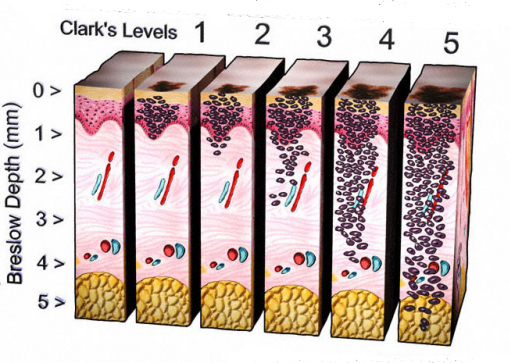
Clinical and morphological classification of melanoma
Specialists distinguish such morphological types of melanoblastoma:
- superficial (surface-spreading) melanoma;
- nodular melanoma;
- melanoma in the place of malignant lentigo (precancerous melanosis);
- acral lentiginous melanoma.
Superficial melanoma
The most common (about 70% of cases) type is a superficial melanoma.
Superficial skin cancer manifests itself in the form of a flat brown or black spot that crawls down the mole.
The tumor occurs on the surface of the head, neck, trunk, lower legs, and thighs. In men, superficial melanoma often affects the back and arms, in women - legs.
The superficial tumor develops slowly and does not grow into the deep layers of the epidermis for a long time. However, when it spreads deep down, itching and ulceration occur. This type of melanoma is well treatable.

Nodular melanoma
Nodular melanoma looks like a domed brown or black spot with or without interspersing. It rises above the skin and is dense to the touch. This type of tumor develops more often on the scalp, face, back.
The node can develop on the surface of other formations (e.g., superficial melanoma);
Nodular melanoma is less common than other types. It rapidly grows and gives metastases to other organs.
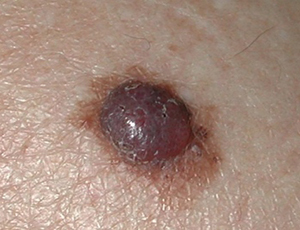
Lentigo melanoma
Malignant lentigo (precancerous melanosis, melanosis of Dubreia) does not have a definite shape and distinct edges. These spots are brown, gray, white on the open areas of the face and body. Melanoma is often taken for freckles. It grows slowly - during 10-15 years. It usually develops in older people.
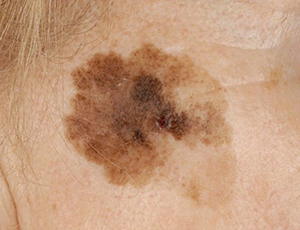
Acral Lentiginous Melanoma
The acral (spotted) melanoma of the extremities is rare. More often it affects the dark skin.
Acrolentiginous melanoma develops on the palms, fingers and toes, feet. Spotted melanoma looks like a dark spot or streak. It also appears on the skin under the nail plate, having the form of a dark brown strip under the fingernail.
Lentigo can stay benign for a long time.
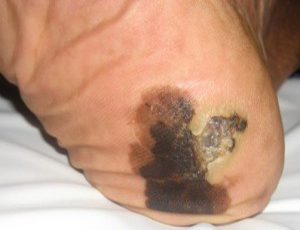
Spindle cell melanoma
The spindle cell melanoma looks like a dome of pink, brown color. It has a smooth or warty surface. It develops on the skin of the head, neck, arms, and legs. Spindle-cell melanoma is more common in children and adolescents.
Dysplastic nevus and melanoma
A dysplastic nevus is an atypical mole, which has a high risk of malignancy. This formation of brown color rises above the surface of the skin. The size is from 1 to 20 mm.

Prognosis of degeneration of dysplastic nevus in melanoma
The more nevuses on the body, the higher the risk of melanoma. In people who have 10 or more atypical moles, the likelihood of developing melanoma increases by 12 times. The nevuses are subject to observation and on-time surgical removal. After the operation, patients undergo regular annual follow-up.
Malignant melanoma (melanoblastoma) depending on localization
Malignant melanoma of the head and face
Melanoma of the face
Malignant neoplasm of the face often appears under the influence of excessive insolation. If the old mole increases in size, changes its color and causes unpleasant sensations, or a new mole appears, it is necessary to consult with a doctor. A specialist will examine the neoplasms, not only on the face but also on the scalp.

Melanoma of the eye
Melanoma of the eye is rare and often is an accidental finding during the ophthalmologic examination. The causes of melanoma development of the eye are not known exactly. Doctors consider that the primary reason is genetic mutations
It affects the retina of the eye, the vascular membrane, the ciliary body, the eyelids. Uveal melanoma looks like a pigmented spot, in 5% of cases it turns out to be a malignant neoplasm. When melanoma appears, it causes unpleasant symptoms. As a tumor grows, patients notice visual disorders, flashes, and spots. At later stages, the perception of light and peripheral vision change.
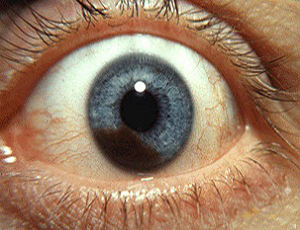
Melanoma of the choroid develops at the age after 50 years. It has a nodular or flat shape. Most often there is a nodular tumor of the choroid, which looks like a round neoplasm. Choroid cancer develops rapidly without noticeable symptoms.
Melanoma of the nasal and mouth mucosa
Melanoma can derive from the cells of the nasal and oral cavity. The tumor affects:
Neoplasms of the mucous membranes has a high risk for metastasizing.
Malignant melanoma of the trunk
Melanoma of the nail
Subungual melanoma is often diagnosed when the affected tissue grows and causes partial rejection of the nail plate. One of the first symptoms of this kind of oncopathology is a black, brown or red spot. As it develops, it increases in size and deforms the nail plate, begins to bleed. Until then, melanoma may not disturb a patient, but later detection increases the risk of tissue infiltration up to the bone.
Subungual melanoma can derive from the nail matrix, the nail plate and the skin tissue adjacent to it.
.jpg)
Melanoma on the back
Melanoma of the back is dangerous because it usually located in the places difficult to access for self-examination.
There are two forms: superficial (70% of cases) and nodular ones. The superficial type is effectively treated and has favorable predictions. A nodular type of melanoma can be a secondary focus of oncology, i.e., metastasis. In this case, the prognosis is poorer.
Melanoma of the vulva and vagina
Usually, melanoma is diagnosed during a routine examination. Pigmented mucosal formations require regular monitoring.
Secondary melanoma
When a tumor grows into the deep layers of the skin, melanoma spreads through the blood and lymph. It affects the brain, liver, lungs, bones.
Melanoma of the liver
Melanoma of the liver is a type of melanoma that occurs as a result of metastasis of the primary tumor. They are the accumulation of melanocytes in the liver. Melanoma of the liver grows rapidly. The liver with melanoma has a tuberous structure and can be enlarged, and its functions are disordered.
Melanoma of the brain
Melanoma of the brain is a secondary malignant tumor consisted of melanocytes. Symptoms of the neoplasm depend on the area of the brain that melanoma affects. The prognosis for melanoma of the brain is poor.
Melanoma of the lungs
Melanoma with metastases in the lung has a poor prognosis. The secondary tumor can be removed surgically only if it is single one.
Melanoma of the bones
Melanoma affects ribs of pelvic and femoral bones, vertebrae and bones of the head (skull).
Forms of melanoma
There are pigmented and unpigmented melanomas.
Pigmented melanoma is a skin tumor that develops from pigment cells. It has a bright color: red, black, different shades of brown.
Non-pigmented (or achromatic) melanoma is much less common than the pigmentary form of melanoma.
Symptoms of non-pigmented melanoma are redness, itching, swelling. At the last stages of development, white melanoma ulcerates and bleeds.
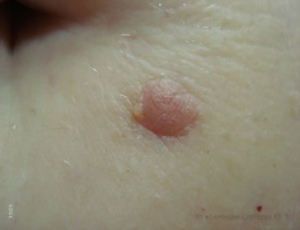
The main danger of achromatic melanoma is the possibility of metastasizing at an early stage.
Melanoma is a quite rare tumor. It affects not only the skin of the face and body but also the mucous membranes, the structure of the eye. Each of these types has features in the symptomatology and treatment. They are united by the type of cells that form the tumor, and rapid spread throughout the body. Therefore, for any suspicious changes in the skin and mucous membranes, you should consult with a dermatologist. Only the on-time detection of melanoma will help to effectively fight it.


